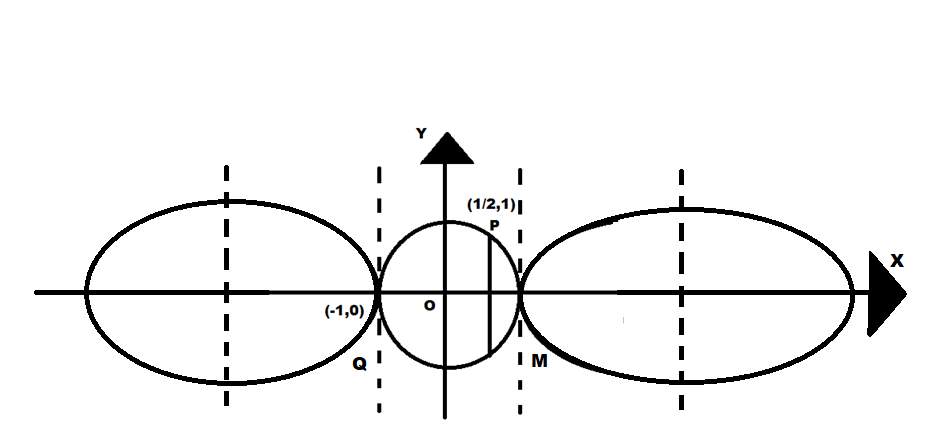Question
Question: An ellipse has eccentricity \[\dfrac{1}{2}\] and one focus at the point \[P\left( \dfrac{1}{2},1 \ri...
An ellipse has eccentricity 21 and one focus at the point P(21,1). Its one directrix is the common tangent nearer to the point P to the circle x2+y2=1 and the hyperbola x2−y2=1 . The equation of the ellipse in the standard form is
A) 91(x−31)2+121(y−1)2=1
B) 91(x−31)2+121(y+1)2=1
C) 91(x−31)2−121(y−1)2=1
D) 91(x−31)2−121(y+1)2=1
Solution
To find the equation of the ellipse we need to find the common tangent for the circle and hyperbola. From the tangent equation find the point neared to P and then find the equation of ellipse by using the fact that the distance of focus to ellipse is equal to eccentricity times the distance between directrix and ellipse and the formula is PQ=e(QM) .
Complete answer:
Given equation of circle is x2+y2=1 and hyperbola is x2−y2=1 .
Now the tangents from these points which are common to both curves is given by
x=1, x=−1
Since the point P(21,1) is given and it is nearer to the line x=1 we consider it as the required tangent.
Given in the equation that this equation is the directrix of the ellipse,
Now to find the equation of ellipse we use the formula
PQ=e(QM)..........(1)
Where P is focus
Q(x,y) is a point of ellipse and
M be a point on the directrix such that the distance which is the foot of the perpendicular of the point Q .
From equation (1) square on both sides of the equation
We get
(PQ)2=e2(QM)2
Substitute the values to find the equation of ellipse
(x−21)2+(y−1)2=(21)2(x−1)2
⇒(x−21)2+(y−1)2=41(x−1)2
Evaluate the obtained equation
⇒(y−1)2=41(x−1)2−(x−21)2
⇒(y−1)2=41(x2+1−2x)−(x2+41−x)
⇒(y−1)2=4x2+41−2x−x2−41+x ⇒(y−1)2=4−3x2+2x
Now rearrange the terms so that we get the ellipse equation (A)
⇒4(y−1)2=−3x2+2x+31−31
⇒3x2−2x+31+4(y−1)2=31
⇒3(x−31)2+4(y−1)2=31
⇒91(x−31)2+121(y−1)2=1
Hence the equation of ellipse is option (A).

Note:
The eccentricity of the ellipse is less than one and the equation has plus sign between xand y . Whereas the eccentricity of the hyperbola is greater than one and for a circle the eccentricity is equal to one. The tangent for a curve at a given point is given by xx1+yy1=1 in some cases.
